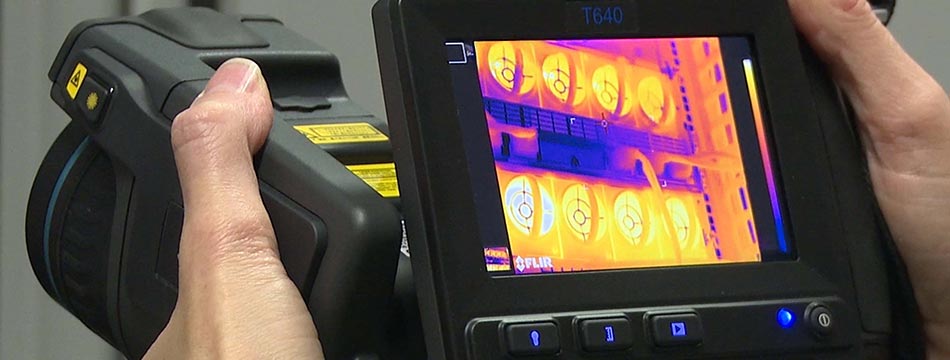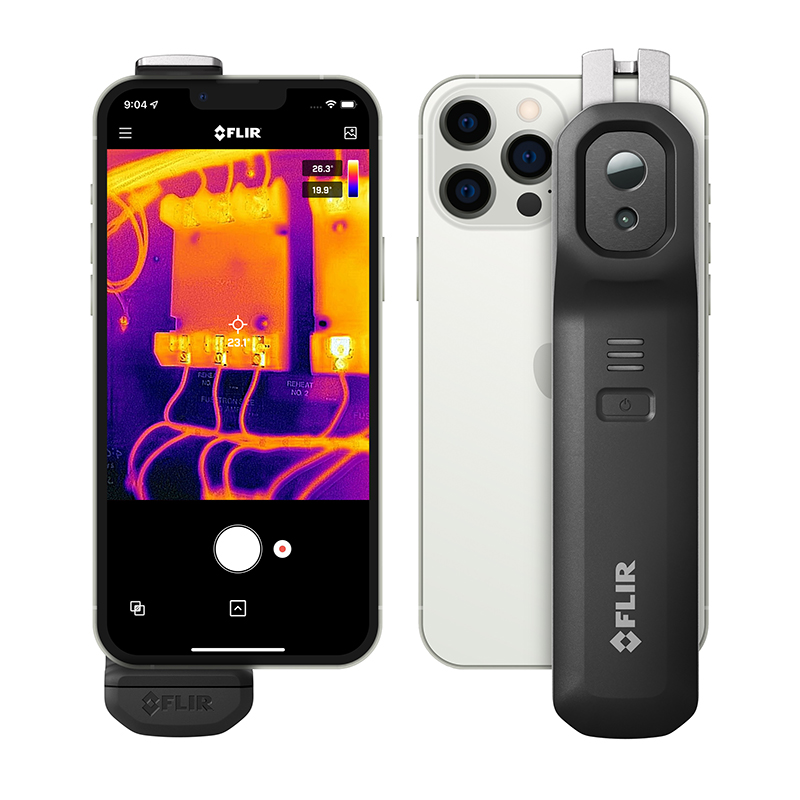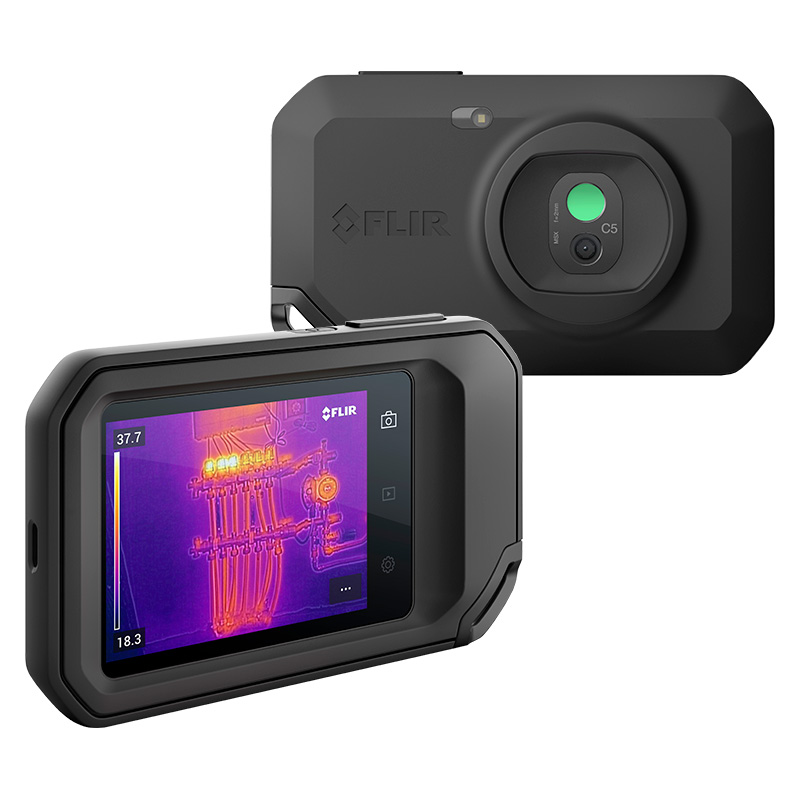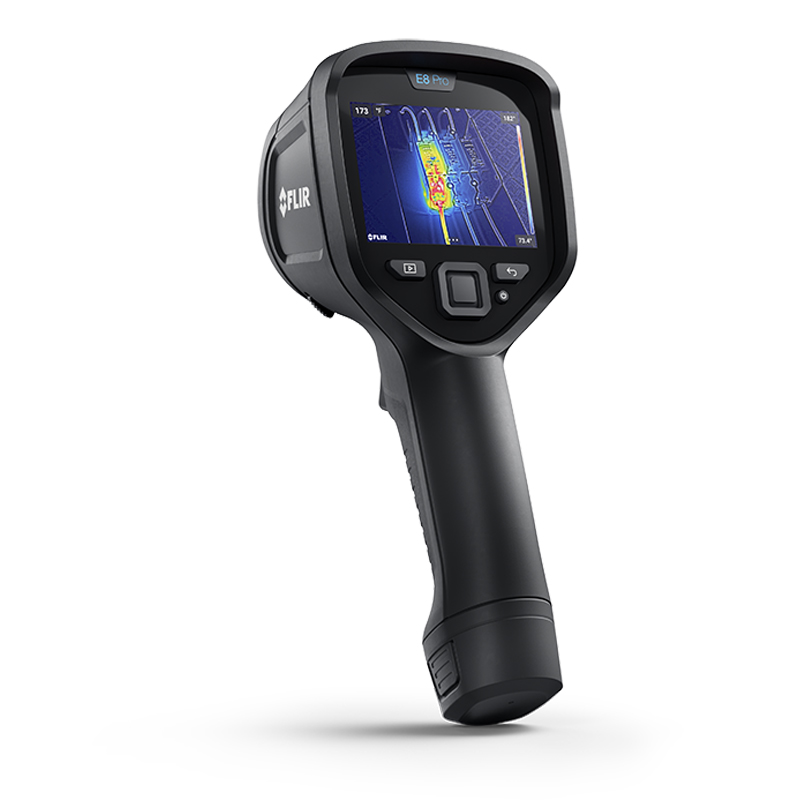
As we come to rely on the internet, data networks, AI, and cloud-based systems more and more, it’ll become increasingly important to ensure the reliability and efficacy of data centres. Unplanned downtime can be very costly both with respect to loss of earnings and business reputation. A Teledyne FLIR case study estimates that data centre companies lose $8000 every minute a plant is down due to an unexpected failure.[1] Spotting potential issues before they become catastrophic faults could eliminate unplanned downtime. Understanding this, Teledyne FLIR offers a range of thermal imaging solutions specifically for this purpose.
Quick Links
- How Can Data Centres Benefit from Using Thermal Imaging?
- Teledyne FLIR Case Study: Why a Data Centre Implemented Thermal Inspections
- Teledyne FLIR Thermal Imaging Cameras
- What to Look for When Using a Thermal Camera to Inspect Data Centres
- Further Information
How Can Data Centres Benefit from Using Thermal Imaging?
Excessive heat is often indicative of impending failure. Thermal imaging cameras allow you to identify overheating electrical and mechanical components, such as transformers or motors, before breakdown happens. Finding potential issues early allows you to address them swiftly before expensive downtime or collateral damage is incurred.
In addition to identifying heat, thermal cameras can pinpoint cold spots. A capability that proves useful when inspecting HVAC systems critical to keeping servers cool and, thereby, maintaining their functionality and warranties. This is significant as server shutdown will affect customers and users all over the globe causing massive economic and reputational damage. Thermal imaging cameras allow you to avoid this completely by identifying components beginning to fail and/or indicating an imbalance in the HVAC system.[2]
Moreover, thermal cameras also offer advantages when reporting and maintaining asset records. Many can measure surface temperature which may be analysed and included as part of reports. Furthermore, regular thermal surveys make it easy to track the condition of assets, providing a useful comparison that allows you to identify trends and spot anomalous temperatures quickly and simply.[3]
Teledyne FLIR Case Study: Why a Data Centre Implemented Thermal Inspections
The main data centre for a discount clothing and home goods retailer needed a way to prevent unscheduled downtime and ensure power usage effectiveness (PUE).[4] A consulting agency advised that implementing Electrical Maintenance Safety Devices (EMSDs), such as IR windows, would be an effective method of improving reliability. On this advice, the business installed 12-inch rectangular IR windows, citing the windows’ large viewing angle and installation flexibility as reasons for their selection.
Via these windows, the data centre could see the critical wire terminations across multiple rear sections of the 2000 A, 480V main switchgear. In turn, this enabled them to check these components for heat anomalies using a handheld thermal camera without the need for special PPE and while keeping the switchgear in a closed, guarded condition. The ease and convenience of the IR windows combined with a thermal camera have led the data centre team to increase their IR inspection frequency. Consequently, the company’s electrical reliability is on track to reach industry-leading levels.
Teledyne FLIR Case Study: Data Centre Implements Infrared Inspection of Critical Switchgear
Teledyne FLIR Thermal Imaging Cameras
In addition to IR windows, Teledyne FLIR offers an extensive range of thermal imaging cameras suitable for surveying data centres and other electrical/mechanical plants.
This seasoned and innovative manufacturer has developed an eclectic collection of infrared cameras covering simple but effective entry-level imagers; accurate yet affordable mid-range models; and powerful and precise premium cameras.

Teledyne FLIR One Edge Pro Wireless Thermal Camera
Entry Model
Price: £469 (Ex VAT)
- Compatible with iOS & Android
- IR Res: 160 x 120px
- Measure temperatures up to 400°C
- Imaging functions: MSX & VividIR
- Use with FLIR Thermal Studio Software; FLIR Ignite Cloud; & FLIR Apps
- Rugged
- Battery Life: 1.5 hours

Teledyne FLIR C5 Compact Thermal Imaging Camera
Mid-range Model
Price: £679 (Ex VAT)
- IR Res: 160 x 120px
- 5MP visual camera
- Measure temperatures up to 400°C
- Imaging functions: Thermal, Visual, MSX, PIP
- 1-Touch Level/Span
- Selectable Thermal Palettes
- Wi-Fi
- Use with FLIR Thermal Studio Software & FLIR Ignite Cloud
- Rugged: IP54, 2m drop tested
- 3.5" touchscreen display
- LED torch
- Battery Life: 4 hours

Teledyne FLIR E8 Pro Thermal Imaging Camera
Premium Model
Price: £3049 (Ex VAT)
- IR Res: 320 x 240px
- 5MP visual camera
- Measure temperatures up to 550°C
- Radiometric thermal imaging
- Imaging functions: Thermal, Visual, MSX, PIP, Thermal Blending
- Selectable Thermal Palettes
- Wi-Fi
- Use with FLIR Thermal Studio Software; FLIR Ignite Cloud; & FLIR Tools App
- Rugged: 2m drop tested
- Lightweight
- 3.5", 640 x 480px touchscreen display
- LED torch
- Battery Life: 4 hours
What to Look for When Using a Thermal Camera to Inspect Data Centres
When using a thermal camera to verify the health of data centres there are ten areas that you ought to incorporate into your maintenance routine.[5]
1.) The Source
When scanning a transformer make sure you use your thermal camera to analyse secondary windings, coils, terminations, lugs, and bolted connections. You should be looking for:
- Thermal anomalies: differences in temperature between similar components; an excessively hot component may be overheating due to a fault.
- Physical damage or debris
- A change in temperature between circuit phases: this could indicate a load imbalance.
2.) Alternate Sources
Ensure you also review alternative power sources for thermal anomalies, changes in temperature, and physical damage. It is essential that secondary power sources are checked while in use and under load.
3.) Standby Generators
Standby generators should also be examined while switched on and under load. As with the power sources above, be sure to scan the standby generator’s secondary windings, coils, terminations, lugs, and bolted connections. Similarly, look out for physical damage/debris, temperature anomalies, and changes in temperature between circuit phases.
4.) Cooling & Exhaust Systems
When checking cooling and exhaust systems, use your thermal camera to record numerical temperatures. Tracking temperatures makes it easy to identify trends and spot anomalies.
5.) Switches
Examine transfer switches when current is running through them and pay particular attention to any heat that may indicate a loose connection as this might mean there is insufficient torque or compression on a lug or termination.
6.) Switchboard
In addition to looking for damage, debris, and imbalance, when conducting thermal observations of switchboards, you should look for thermal anomalies across connections, bus connections, terminations, fuses, and fuse clips.
7.) Uninterruptible Power Supply (UPS)
To thermally survey a UPS, you ought to work under load and scan the following:
- Input connections
- Terminals
- Inverter sections: specifically small fuses and capacitors.
- Battery section: pay particular attention to the terminal posts, casings, and feeders; additionally, test whether the cell heats up quickly under load and/or cools quickly when the load is removed because both conditions can be indicative of bad batteries.
- On-board transformer (if there is one)
8.) Power Distribution Units (PDUs)
When using a thermal camera to monitor PDUs, ensure that you analyse the lugs, terminals (including circuit breaker terminals), and onboard transformer (if there is one).
9.) Server Racks
Thermal cameras can be used to scan server racks for overheating components caused by loose connections and loose or bent plugs. They also prove useful for identifying broken cords and conductors in wires. When monitoring server racks, ensure you check power strips, power supplies built into the racks, wiring connections, plugs, and plug strips.
10.) Air Cooling Effectiveness
As mentioned previously, air cooling systems are critical to maintaining the condition of servers. Therefore, thermal monitoring of data centres should always involve surveying server rack cooling systems and HVAC systems.
Server Rack Cooling Systems
Thermal imaging cameras offer one method of assessing the efficacy of server rack cooling systems. They can be used to map cooling patterns into, out of, and around server racks, with a view to assessing whether cooling is sufficient and identifying where to install perforated panels to improve circulation and/or blanking plates to prevent hot air from entering empty slots on unfilled racks.
HVAC Systems
To prevent servers from automatically shutting off due to high temperatures, many data centres employ HVAC systems to cool the environment. As a result, ensuring the condition of AC systems becomes critical. Using a thermal camera, you can check fuses, terminations, lugs, crimped or bolted connections, and mechanical components for overheating that may signal misalignment, unbalance, or degradation. Infrared imaging will also reveal whether there is a refrigerant leak and/or if the cooling towers are leaking.
Further Information
For more information about using thermal cameras for monitoring data centres or for additional details regarding any of our thermal cameras, including our extensive range of Teledyne FLIR models, please don’t hesitate to contact our Sales team on 01642 931 329 or via our online form.
Browse Electrical & Mechanical Inspection Thermal Cameras
Shop Teledyne FLIR Electrical & Mechanical Inspection Thermal Cameras
[1]Teledyne FLIR, Data Center Implements Infrared Inspection of Critical Switchgear, last accessed 07 October 2023.
[2] Fluke, Where to use thermal cameras in data centers, last accessed 07 October 2023; and Jack Portley, ‘Why Thermal Imagers are Important for Data Centres’, KnowHow, last accessed 07 October 2023.
[3] Fluke, Where to use thermal cameras in data centers.
[4] All the information for this section was gathered from:
[5] All the information for this section was gathered from:


